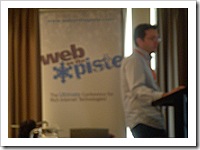RIA, the two C's rule.

Sitting in a conference (WebOnThePiste.com) here in New Zealand, reflecting on my previous day where Nigel Parker (NZ) and I were invited to be apart of a Panel discussion with our Australian Adobe colleagues on "RIA & The Future".
I wish it was filmed, for not only because it would of captured the gorgeous scenery of Queenstown - New Zealand, but because it was probably one of the best RIA conversations I've had in quite a while as all 4 of us get RIA ( yet each of us have a product story to tell that's different to one another, but the concept held overall).
The question put forward to us was quite a hard one to respond to (choosing wording carefully etc).
"It's 2009, the web has grown, and RIA is in full swing, what does a typical website look like on this day, 2009".
We all had our piece, Adobe raised some valid points, about user experience and ensuring rich content is re-mastered to suite the RIA paradigm. I agreed with a lot of their points and they are quite valid.
My thoughts however settled around "Unified View over Disparate Systems" (something a friend taught me many moons ago). In that, the forward momentum for RIA is about two simple rules, Content and Context.
Content is important, it's a commodity we trade with day in day out online, we need to ensure we can reproduce a variety of content and deliver it to as many marketing/channels we can with minimal overhead and without delay.
Yet, content on its own is useless - it's just large packets of data being pushed in a direction. That is until context plays a role, context gives you conversation. Context gives you experience and it's the piece that helps produce a successful RIA.
RIA in general (no matter if you choose Flash/AIR/Silverlight/WPF) is essentially about ensuring the content is aggregated in a way that puts such content into the right context, in that addressing a user's probable pain points through a sensory engaging experience.
This is what it's all about, getting content into the hands of those whom need it, through simple, painless execution and using as many sensors a human being is willing to donate via a computer or device.
Content isn't king, context is.
Yet, what's an example of this. I look at the Airline demo that is used to demo Silverlight. I choose this for a number of reasons, but mainly because its taken a lot of basic features within Silverlight and doing quite a lot with little. It's got a basic functionality associated to it, in that let's assume the content is coming from an aggregated live data center. I am a user, and I need the ability to travel from Brisbane, Australia to Queenstown, New Zealand. Personally couldn't care what airline goes there, but I need to be there prior to the conference starting.
This in turn provides context to the content, I need to get from A to B, but I understand that there will be connecting flights, from multiple locations. In turn, I find what I think is the shortest route or bypasses main airport hubs like Sydney, Australia (trust me, trick to travel is move away from hubs, less Airport nightmares are likely to occur).
It empowers me to visually see my potential paths of choice, it also enables me to focus on timing and lastly it could provide pricing (insert usability discussion here later). Overall, it's taking a massive amount of data (content) and distilling it down into solving (context) my pain points (time + schedule - price).
I could offer more examples of this concept, but Context is King, Content just fuels Context.